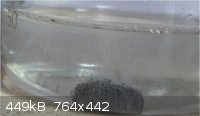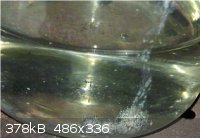| Pages:
1
2 |
Tdep
National Hazard
   
Posts: 519
Registered: 31-1-2013
Location: Laser broken since Feb 2020 lol
Member Is Offline
Mood: PhD is done! It isn't good but it's over lol
|
|
Gallium trioxide? I did that by dissolving some gallium in hydrochloric acid (which took quite some time, only a bit faster than tin in my
experience). This gallium trichloride was then neutralized with NaOH to precipitate gallium trioxide.
It was quite hard balancing the levels of acid to base, as any excess of either would cause the white precipitate to redissolve. But, I guess you want
it to redissolve if you want to form sodium gallate (?)
And some pictures, as someone requested. Used the sort of black oxide layer that my gallium seemed to form that didn't look so good, so that's why
it's black in the first photo. It eventually (after about a week of room temperature reacting) melted and formed quite beautiful silver balls that
were great to watch slowly bubble away.
Also, sorry about the horrible dirty outside of the beaker haha. Quite ruins the photo
 
|
|
|
bismuthate
National Hazard
   
Posts: 803
Registered: 28-9-2013
Location: the island of stability
Member Is Offline
Mood: self reacting
|
|
Thanks for the pics! On another note if I recall correctly the neutralization of GaCl3 yields Ga(OH)3.
|
|
|
Tdep
National Hazard
   
Posts: 519
Registered: 31-1-2013
Location: Laser broken since Feb 2020 lol
Member Is Offline
Mood: PhD is done! It isn't good but it's over lol
|
|
I mean, I did dry it using heat that would have decomposed the hydroxide so for me it's not a huge deal but reference:
Gallium oxide is precipitated in hydrated form upon neutralization of acidic or basic solution of gallium salt
Or is the 'hydrated form of the oxide' actually the hydroxide?
|
|
|
blogfast25
International Hazard
    
Posts: 10562
Registered: 3-2-2008
Location: Neverland
Member Is Offline
Mood: No Mood
|
|
Quote: Originally posted by Tdep  | It was quite hard balancing the levels of acid to base, as any excess of either would cause the white precipitate to redissolve. But, I guess you want
it to redissolve if you want to form sodium gallate (?)
|
If you don't want gallate to form, use ammonia to neutralise the GaCl3 with because NH3 is too weak a base to form Ga(OH)4-
anions. With ammonia Ga(OH)3.nH2O will form only.
On the other hand, it may be advantageous to have the gallium as gallate to prepare the thiogallate. Gallate solutions are alkaline and alkaline
solutions absorb H2S readily.
But will the substitution reaction (here schematic):
Ga(OH)4- === > Ga2S42- actually take place? Hmmm...
For all intents and purposes, yes. Varying degrees of hydration result from varying conditions of precipitation such as alkalinity, Ga concentration
and temperature. But what precipitates is never stoichiometrically 'Ga2O3'.
Interesting how you found the reactivity towards HCl subjectively lower than that of Al. I kind of expected the opposite...
[Edited on 10-11-2013 by blogfast25]
|
|
|
bismuthate
National Hazard
   
Posts: 803
Registered: 28-9-2013
Location: the island of stability
Member Is Offline
Mood: self reacting
|
|
My thoughts exactly. I believe that when Ga2O3 and metal carbonates are heated in the usual process they form gallates wich then proceed to react with
H2S. However that way would cause impurities and require more heat, so I came up with this.
Another idea CaS+Ga2S3-->CaGa2S4?
|
|
|
blogfast25
International Hazard
    
Posts: 10562
Registered: 3-2-2008
Location: Neverland
Member Is Offline
Mood: No Mood
|
|
Quote: Originally posted by bismuthate  | [...] are heated in the usual process they form gallates wich then proceed to react with H2S. However that way would cause impurities and require more
heat, so I came up with this.
Another idea CaS+Ga2S3-->CaGa2S4? |
What do you understand by 'the usual process'? Dry or wet?
CaS + Ga2S3 would have to be done by fusion. CaS hydrolyses like mad in water and is in any case hard to get.
Do you have any date/references on the solubility of some of these gallates? I've seen formulas like CdGa2S4 and SrGa2S4 for phosphors. No idea how
they are prepared though.
|
|
|
bismuthate
National Hazard
   
Posts: 803
Registered: 28-9-2013
Location: the island of stability
Member Is Offline
Mood: self reacting
|
|
Oh sorry well all ways are dry. The usual way is heating a metal carbonate with Ga2O3 and H2S gas. I can't find anything about the solubilities the
only info I found was about phosphorescence and synthesis. The sulfide fusion idea is merely speculation.
|
|
|
blogfast25
International Hazard
    
Posts: 10562
Registered: 3-2-2008
Location: Neverland
Member Is Offline
Mood: No Mood
|
|
Quote: Originally posted by bismuthate  | | Oh sorry well all ways are dry. The usual way is heating a metal carbonate with Ga2O3 and H2S gas. I can't find anything about the solubilities the
only info I found was about phosphorescence and synthesis. The sulfide fusion idea is merely speculation. |
Ok. In that case you really need anhydrous Ga2O3. Easier to wash, dry and calcine Ga(OH)3 than pyrolyse Ga(NO3)3, IMO. The latter may be difficult to
isolate and removing the last bits of nitrogen may also be hard to do. By contrast, any traces of NH4Cl in the precipitated and washed Ga(OH)3 will
easily come off on heating.
[Edited on 10-11-2013 by blogfast25]
|
|
|
bismuthate
National Hazard
   
Posts: 803
Registered: 28-9-2013
Location: the island of stability
Member Is Offline
Mood: self reacting
|
|
I only have an alcohol burner for heating. Heating the hydroxide would not decompose it with such a weak flame I fear.(Ga(NO3)3 decomposes a 250
celcitus) This is besides the point since I will use the gallate method.
|
|
|
blogfast25
International Hazard
    
Posts: 10562
Registered: 3-2-2008
Location: Neverland
Member Is Offline
Mood: No Mood
|
|
Quote: Originally posted by bismuthate  | | I only have an alcohol burner for heating. Heating the hydroxide would not decompose it with such a weak flame I fear.(Ga(NO3)3 decomposes a 250
celcitus) This is besides the point since I will use the gallate method. |
Actually, the hydroxide would decompose well before the nitrate, in all likelihood.
|
|
|
bismuthate
National Hazard
   
Posts: 803
Registered: 28-9-2013
Location: the island of stability
Member Is Offline
Mood: self reacting
|
|
Thats odd most sources I've seen say that it first decomposes into an oxide hydroxide first. Wiki says that it decomposes to Ga2O3 at 400 celcius.
|
|
|
bismuthate
National Hazard
   
Posts: 803
Registered: 28-9-2013
Location: the island of stability
Member Is Offline
Mood: self reacting
|
|
Bad news I have failed to make sodium gallate repeatedly (my filter didn't work to filter Ga(OH)3 over and over and I lost it) . Since I do not want to waste any more gallium I plan to try to synthesize sodium
thioaluminate by the same process except replacing sodium gallate with sodium aluminate as a test run. . Since I do not want to waste any more gallium I plan to try to synthesize sodium
thioaluminate by the same process except replacing sodium gallate with sodium aluminate as a test run.
[Edited on 26-11-2013 by bismuthate]
|
|
|
Eddygp
National Hazard
   
Posts: 858
Registered: 31-3-2012
Location: University of York, UK
Member Is Offline
Mood: Organometallic
|
|
Of course, if you have the necessary equipment, you can try to prepare a gallide, a telluride (love them) or a bismuthide.
there may be bugs in gfind
[ˌɛdidʒiˈpiː] IPA pronunciation for my Username |
|
|
bismuthate
National Hazard
   
Posts: 803
Registered: 28-9-2013
Location: the island of stability
Member Is Offline
Mood: self reacting
|
|
Shame I don't.
Well, good news. Today I led H2S over less than a gram of sodium aluminate. At first the gas that pssed over it had no oder leading m to believe it
was reacted. When I added HCl to the mystery product it bubbled and smelled like H2S, so it may be thioaluminate
|
|
|
bismuthate
National Hazard
   
Posts: 803
Registered: 28-9-2013
Location: the island of stability
Member Is Offline
Mood: self reacting
|
|
Eddygp, you mentioned gallides. Do you have any info on their synthesis?
|
|
|
| Pages:
1
2 |